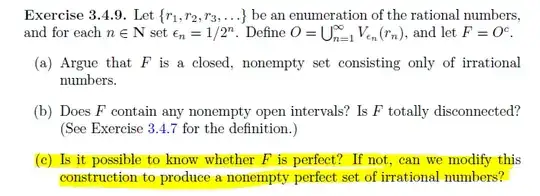A proof that an enumaration of the rationals exists such that the resulting $F$ has an isolated irrational point $x$, which can be chosen freely.
This proof has 3 parts:
Finding a sequence of different rationals (to be placed as $\{r_{4n}\}$) such that $\bigcup_{n=1}^\infty B(\epsilon_{4n};r_{4n})$ is a cover for the half-open interval $[a_1, x)$, with some $a_1 < x$ and that cover not containing $x$.
Similiarly, finding a sequence of different rationals (to be placed as $\{r_{4n-2}\}$) such that $\bigcup_{n=1}^\infty B(\epsilon_{4n-2};r_{4n-2})$ is a cover for the half-open interval $(x, b_1]$, with some $b_1 > x$ and that cover not containing $x$.
Finally, putting all the remaining rationals into the odd spots of the enumaration ($\{r_{2n-1}\}$), such that $B(\epsilon_{2n-1};r_{2n-1})$ does not contain $x$.
If all of this is done, then $x$ is the only point from the interval $[a_1, b_1]$ that lies in $F$ (and it is not a boundary point), so $x$ is isolated.
Step 1:
Given any real number $a_1$ and a positive $d$, one can construct real numbers $$d_1=0.9d, d_{n+1}=\frac1{16}d_n, n=1,2,\ldots$$
From this, one can construct $a_2, a_3,\ldots$ such that $a_{n+1} - a_n =d_n$ for $n=1,2,\ldots$ We have $a_n = a_1+ \sum_{i=1}^{n-1}d_i = a_1+ \sum_{i=1}^{n-1}\frac{d_1}{2^{4(i-1)}}$ and thus $\lim_{n \to \infty} a_n = a_1+\frac{16}{15}d_1$.
Let the closed intervals $[a_n,a_{n+1}]$ be denoted as $I_n, n=1,2,\ldots$ The length of each $I_n$ is equal to $d_n$, which is equal to $0.9\frac{d}{2^{4n-4}}$.
Set $d=\frac{2}{2^4}$. This makes $d=2\epsilon_4$, so $d$ is the length of the open interval $B(\epsilon_4;r_4)$. It's easy to see that generally $\frac{d}{2^{4n-4}}$ is the length of the open interval $B(\epsilon_{4n};r_{4n})$. So we have that the length of $I_n$ is 90% of the length of the open interval interval $B(\epsilon_{4n};r_{4n})$.
Finally, choose $a_1 = x-\frac{16}{15}d_1$. This means the $\{a_n\}$ form an increasing sequence whose limit is $x$.
Now we pick rationals $r_{4n}$ in increasing sequence, starting with $r_4$. This is done in such a way that
- $B(\epsilon_{4n};r_{4n})$ covers $I_n$ (easily done with enough 'wiggle room' to have an infinite choice of potential $r_{4n}$),
- $B(\epsilon_{4n};r_{4n})$ does not contain $x$ ($x>a_{n+1}$ makes sure there is 'space' to find for the upper boundary of $B(\epsilon_{4n};r_{4n}))$, and
- $r_{4n}$ is different from all previously chosen $r_{4i}$ (possible because condition 1 and 2 still leave an infinite amount of possible choices).
Obviously, we have $r_{4n} < x$ for all $n=1,2,\ldots$ Additionally, we have $\lim_{n\to \infty}r_{4n} = x$. That means any interval whose closure is not containing $x$ only has a finte number of $r_{4n}$ in them.
This concludes step 1 of our prove, as $\bigcup_{n=1}^{\infty}I_n=[a_1,x)$ and $I_n \subset B(\epsilon_{4n};r_{4n}), n=1,2,\ldots$
Step 2 can be done analogously. The $\{b_i\}$ will decrease this time instead of the incereasing $\{a_i\}$, and $d=\frac{2}{2^2}$ is chosen such that $d$ becomes the length of $B(\epsilon_{2};r_{2})$. The chosen $r_{4n-2}$ are all greater than $x$, so they are all different from the chosen $r_{4n}$.
For step 3, we partition the rationals $\mathbb Q$ into classes $\mathbb Q_1, \mathbb Q_2, \mathbb Q_3 \ldots$ such that
$$\mathbb Q_1 = \{r \in \mathbb Q: \epsilon_1 < |x-r|\} $$
$$\mathbb Q_n = \{r \in \mathbb Q: \epsilon_{2n-1} < |x-r| < \epsilon_{2n-3}\}, n=2,3,\ldots$$
This is a partition as any $|x-r|$ is irrational, so cannot be $0$ or any $\epsilon_k$. The lower bound for $\mathbb Q_n$ is the upper bound for $\mathbb Q_{n+1}$, so there are no gaps. Let $R$ be set set of rationals not already chosen for $r_{4n-2}$ or $r_{4n}$. The closure (in the reals) of each $\mathbb Q_n$ is a finite union of intervals not containing $x$, so each $\mathbb Q_n$ only contains a finite number of rationals from $\mathbb Q\backslash R$. That means each
$$R_n = \mathbb Q_n \cap R, n=1,2,\ldots$$
contains an infinite number of rationals.
Each $R_n$ can be enumerated:
$$R_n = \{r_{n1}, r_{n2},\ldots\}, n=1,2,\ldots$$
These enumerations can be combined to form a full enumeration of $R$:
$$R = \{r_{11}, r_{12},r_{21}, r_{13}, r_{22}, r_{31}, r_{14}, \ldots \}$$
This is the classical diagonal enumeration used in the prove that an infinte countable union of infinite countable sets its again countable. We fill the gaps in our enumeration of all rationals (the odd indices) by the elements of $R$ in that order: $r_1=r_{11}, r_3=r_{12}, r_5=r_{21},\ldots$.
So the first time an element of $R_n$ comes up in the enumaration of $R$ is at position $\frac{n(n+1)}{2}$. That element becomes $r_{n(n+1)-1}$. By the definition of $R_n \subseteq \mathbb Q_n$ we have $|x-r_{n(n+1)-1}| > \epsilon_{2n-1}$. It is easily seen that $n(n+1)-1 \ge 2n-1$ for all $n \ge 1$ (equality holds just for $n=1$). Since the $\epsilon_k$ are decreasing it follows that $x \notin B(\epsilon_{n(n+1)-1};r_{n(n+1)-1})$. Any element of $R_n$ that apears later will have an even higher index $k>n(n+1)-1$ in $\{r_k\}$, which corresponds to an even lower $\epsilon_k$ and thus $x \notin B(\epsilon_k;r_k)$ for all odd $k$ follows.
This concludes the proof.
